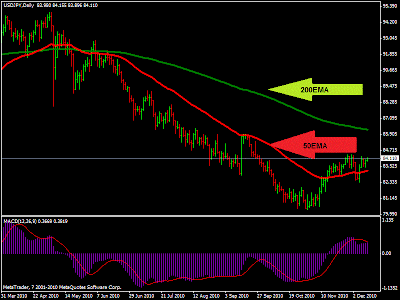Technical indicators classified into two groups:
1. Non-trending indicators, also known as Oscillators. For instance, RSI
2. Trend following indicators, eg Moving Average
Moving Average
1. Using single moving average:
A price crossing of the moving average provides buy/sell signal. Buy when price is above MA, sell when price is below MA.The disadvantage of single MA is you will encounter price crossing MA & again crossing, this phenomenon we called as whipsaw, it's common when price is at consolidation or sideway.
2. Using Double moving average:
Also known as double crossover method. When using two MA, buy signal is produce when a faster MA cross above a slower MA, sell signal when faster MA cross below a slower MA.
Using Double MA will cut off whipsaws but it normally will result time lag.
3. Using three Moving Average
Buy signal is produced when the fastest MA crosses above both the slower MA, a sell signal when the fastest MA crosses below both slower MA.Using three MA will take the slowest MA as a trend indicator & use the crossover of the other two MA as sell or buy signal.
Summary:
The moving average is calculated from a series of past data, the data will have a time lag. The greater the number of periods, will lead to greater time lag. However, the smaller number of periods will lead to more sensitive data, thus will cause whipsaw due to lots of signals. When using MA, we need to try to form a balance. One way is use MA conjunction with another indicator. Both indicators will help to confirm each other on signal.
Moving Average Convergence & Divergence Indicator (MACD)
In MACD, we always look at the:
1. Zero Line crossovers - when MACD crosses below zero line, a sell signal generated while a buy signal when it is above zero line.
2. Signal Line crossovers - If MACD line crosses the signal line to the upside, a buy signal, conversely when crosses signal line at downside, it is a sell signal. The location of the crossover also important indicate how strong of the trend. A bullish crossover of the MACD & signal line below zero is more bullish.
3. Divergence - As mentioned in earlier post, MACD divergence is the most important indicator to identify a reversal. To review, please review again : MACD in earlier post.
Summary:
To me, MACD is most powerful indicator when come to identify the trend using convergence & divergence. These will give a powerful signal for reversal. The rule of thumb, a strong buy/sell signal still come from price pattern & price action.
Relative Strength Index (RSI)
RSI is one of the simplest indicators & among the favourites in trading. RSI basically measures market internal strength and give an indication of overbought & oversold market condition. A reading of above 70 indicates a overbought market, a reading below 30 indicates a oversold market. We use RSI for:
1. Tops & bottom - as mentioned, it show overbought & oversold.
2.Support & resistance - RSI who the level of support & resistance, where we can predict price support & resistance.
3. Divergence - Similar to MACD, it's a reversal trend change.
Summary:
Using overbought & oversold sometimes be misleading. When market is strong, it tends to go overbought & stay for a period of time. The RSI work best when market is in non-trending condition.
So far, you will realize that an individual indicator may not work in all market condition, so we need to combine one indicator with another to increase the efficiency of the indicators across all markets.
There are many resources that you can find out from Amazon to enhance your skill in technical analysis, below are some recommend resources:




















